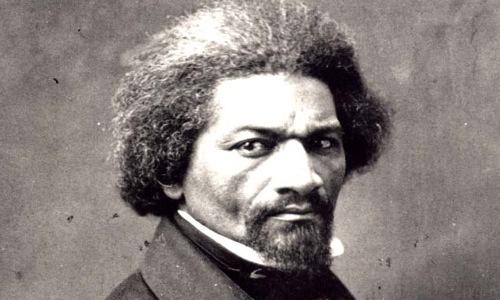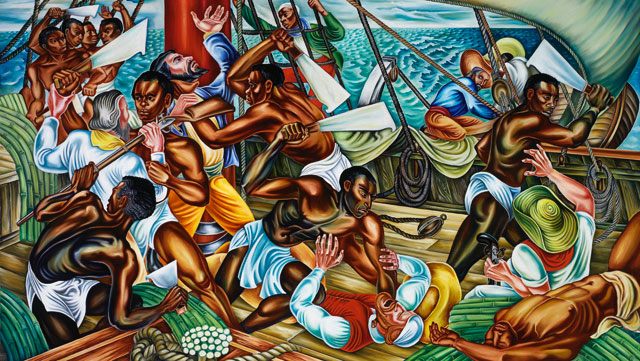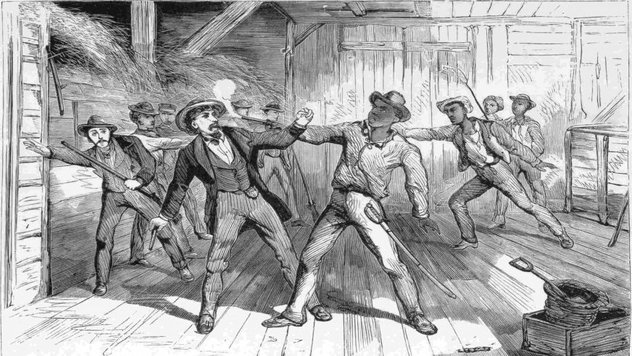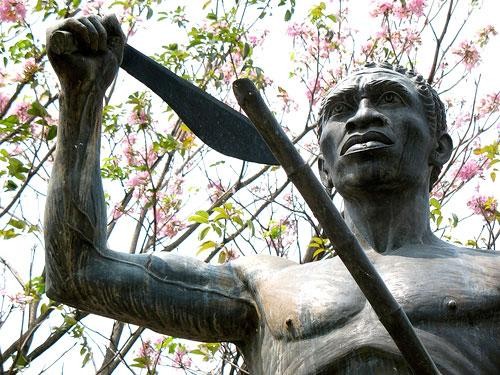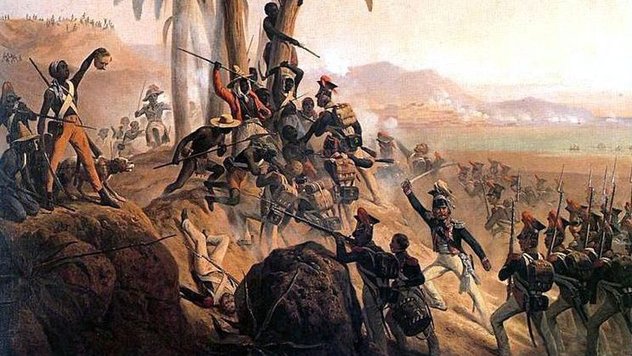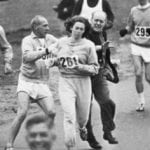10Isaac Burgan
Isaac Burgan was just a kid when he decided to fight back. Burgan grew up on a North Carolina plantation where his mother, Sylva, worked as a house slave. She took him along daily to the “Big House” where he learned how to read and write from the white kids. Soon, his increasing education made his owners nervous, but he calmed their fears by using his brain for the good of the farm. Thanks to his smarts, Isaac became an influential figure on the plantation, getting perks other slaves didn’t get. But Isaac’s clout couldn’t keep his mother safe. When she angered the bosses, the overseer decided it was time for a beating. Isaac heard her screaming as the whip tore at her back and was suddenly faced with the biggest decision of his young life. Should he stay out of it? Or save her? The choice was simple. Isaac picked up a heavy iron poker, walked up behind the overseer, and caved in the back of his head. Nobody messed with his mom. After the overseer woke up with a splitting headache, Isaac received twice the beating his mother would have gotten. But Isaac survived and went on to live a happy, productive life. After the Civil War, Isaac earned a B.A., D.D., and LL.D. and became a pastor, teacher, and the president of Paul Quinn College in Waco, Texas.
9Frederick Douglass
Frederick Douglass, one of the most influential abolitionists of the 19th century, toured both the US and Great Britain, speaking against slavery. He wrote a bestselling autobiography and served as a preacher, publisher, and politician. He met with Abraham Lincoln, promoted education, and championed equal rights for everyone. And when he was a teenager, he went toe-to-toe with one of the meanest slave owners in the South. At 16, Douglass was rented out to Edward Covey, a notorious slave breaker who looked for any excuse to use his whip. He even hid in the grass to spy on his slaves in the hope he’d catch them taking a break. And when Douglass showed up, Covey planned on turning him into a mindless, obedient drone. He whipped Douglass at least once a week for the next six months, once beating him so hard that the stick he was using broke in half. Douglass didn’t even have time to heal from his wounds before Covey decided it was time for more punishment. And to Douglass’s horror, he found he was being “tamed.” Covey was crushing his spirit. Things changed though when Douglass saw a ship in Chesapeake Bay. Inspired by the ship’s “freedom,” he vowed to become a free man. He tried running away to ask his old master for help, but the man just laughed and sent Douglass back to Covey—who was waiting. While Douglass was working in the barn one day, Covey sneaked up behind him with a rope, tying the teen’s legs together. Suddenly, Douglass reached his breaking point. He tried to jump away, but Covey held on, taking Douglass to the floor. But when Douglass regained his footing, he grabbed Covey’s throat and choked him so hard that the slaver started to bleed. Covey was terrified. None of his slaves had ever fought back before. He called for help, and a white servant showed up with a rope. When he tried to tie Douglass’s free hand, Douglass landed a perfectly aimed kick into the man’s ribs. When a second guy showed up and saw what was happening, he decided he wasn’t getting paid enough and ran away. Desperate, Covey tried to reach a club outside the barn door, but Douglass grabbed him with both hands and hurled him to the ground, judo style. This battle between slave and racist went on for two brutal hours. Eventually, Douglass let Covey go . . . and Covey never touched him again. Douglass’s victory fueled his desire to escape, and in 1838, he finally did, beginning a new fight against slave owners everywhere.
81842 Cherokee Slave Revolt
Not all slave owners were wealthy white guys sipping juleps on cotton plantations. In an effort to become like white Americans, the Five Civilized Tribes (Cherokee, Chickasaw, Choctaw, Creek, and Seminole) became farmers, opened public schools, and started buying black people. After all, it was the American way. The Cherokees owned over 4,000 slaves, and took 1,592 with them down the Trail of Tears. These slaves mostly belonged to mixed-race Cherokees who employed them as interpreters, servants, and farmhands. But as it turns out, Cherokee farmers weren’t any better than their white counterparts, so the slaves decided to fight back. On November 15, 1842, Joseph Vann’s slaves were up bright and early, planning to take advantage of their master’s white ways. The Cherokees had given up their mud huts for log cabins and clapboard houses, and their new homes came equipped with doors. So while the Cherokees slept, the slaves locked them in their houses and then stole horses, guns, and supplies. Their plan was to meet up with a band of Creek slaves and head to Mexico, which was closer than Canada and just as slave-free. After the Cherokees finally broke down their doors, they organized a search party and caught up with the runaways on the open prairie. The slaves took shelter in a deep depression that provided cover from all sides and began firing at their pursuers. The gun battle lasted for two straight days before the Cherokees decided they needed backup and retreated. The slaves saddled up and continued south. Along the way, they rescued some Choctaw slaves from two bounty hunters, neither of whom would ever collect another bounty. Unfortunately, the Cherokee National Council convened a meeting where they decided to send 87 members of the Cherokee Militia after the slaves. When the soldiers caught up with the runaways, they found a sad sight. The slaves had run out of supplies and were starving and too exhausted to fight back. Five were handed over to the military to stand trial for the murder of the slave hunters, and the rest were forced into hard labor.
7The 1811 Slave Rebellion
The last thing any racist wants to see is hundreds of armed slaves waving banners and beating drums while marching down the road, but that’s what happened in January 1811, when Charles Deslondes led the largest slave revolt in US history. Sick of working on a Louisiana plantation, Deslondes organized a massive rebellion—which was no easy feat. Over several years, he secretly communicated with slaves across the Louisiana coast, holding meetings in fields, taverns, and at slave gatherings. He also had to overcome massive language barriers because many of his fellow slaves had come straight from Africa and Haiti. But finally, on January 8, 1811, Deslondes made his move. The slaves of the Woodland Plantation armed themselves with hoes, axes, and cane knives, hacked up their masters and marched west, where they met with slaves from a second plantation (led by two Ashanti warriors, no less). There were now 200–500 slaves on the warpath, burning every plantation they came across. And while they spared women and children, they made short work of the men. This was every Southerner’s nightmare, and the roads to New Orleans were backed up for miles with whites running for their lives. The government sent the military to challenge Deslondes, and since the slaves had few guns, they had to retreat. They didn’t get far before they were trapped by a local militia. With nowhere to go, the slaves threw down, fighting valiantly with their farm tools, but in the end they were simply outgunned. The slaves who didn’t escape into the swamps were captured and executed. As he was the leader, Deslondes’s corpse was mutilated. Finally, the racists stuck the rebels’ heads on spikes and set them along the river from New Orleans to LePlace to serve as a warning to any slave thinking about fighting back.
6The Amistad Rebellion
In 1839, a group of Africans were kidnapped near Sierra Leone and sold to Spanish slavers—despite the fact that importing slaves from Africa was illegal in 1839. The slaves were taken to Cuba and loaded aboard the Amistad (Spanish for “friendship,” because what’s friendlier than a slave ship?). However, the Africans had no intention of going anywhere, especially after the Amistad’s cook told them the Spanish planned to eat them. As the ship sailed away from Cuba, 25-year-old Sengbhe Pieh, aka Cinque, used a long nail to open the lock on his collar and free his comrades. While the sailors battled a storm, the Africans found a supply of sugar cane knives and rushed the deck. The overwhelmed crew never had a chance. The rebels killed the captain and the cook and ordered two Spanish captives to sail towards Africa. The Spanish complied . . . during the day. At night, they turned the boat around, picked up the pace, and headed towards America. Two months later, the Amistad arrived in New York where the slaves were seized by American troops. They then fought a much bigger foe than Spanish slavers: the American government. Cinque and his friends were tried for murder, and the case divided the nation. Abolitionists ran to the prisoners’ defense, while President Martin Van Buren took a pro-slavery stance in the hope of appeasing the Spanish government—and Southern voters. Secretary of State John Forsyth even ordered a ship to be ready the minute a guilty verdict was handed down. That way, the slaves could be whisked away to Cuba before having a chance to appeal. However, things didn’t go as Van Buren had hoped. The judge ruled since it was illegal to take slaves from Africa, the Africans had been acting in self-defense and found them innocent. But Van Buren, a sore loser, ordered an appeal, and the case went to the Supreme Court. Cinque and his friends were defended by the staunch abolitionist, and former American President, John Quincy Adams, who argued the Africans had a right to freedom. In March 1841, the court ruled that the Africans could go home. After three long years, 35 of the survivors finally returned to Sierra Leone, where they established a settlement and sparked reforms which led to the country’s independence from Britain.
5Creole Slave Revolt
The Creole was a slave ship headed for New Orleans with a “cargo” of 135 slaves—but it would never make it to port, because there was a real-life Django on board. Madison Washington was the ship’s cook and a man who’d escaped from slavery once before. He’d fled to Canada, but returned to Virginia to rescue his wife, Susan. Unfortunately, he was captured and sold, but he had every intention of finishing his mission. As the Creole sailed through the Atlantic, Washington began making escape plans with 18 other slaves. On the night of the rebellion, the chief mate suspected that something was going on. He confronted Washington, but the cook fought back, sparking the revolt. The rest of the slaves rushed their captors, and in the struggle, one slave and one slave owner were killed, and the captain was wounded. The slaves were now in control of the ship, and unlike the captives aboard the Amistad, these guys were experts in slave law, sailing, and geography. They knew their best chance was to sail for the Bahamas, a British colony where slavery was illegal. They also knew about navigation so they weren’t going to be fooled like the Amistad slaves. They ordered the crew to take them to the Bahamas or be thrown overboard. The sailors chose wisely. When they arrived in the Bahamas, all the slaves were freed except for Washington and his 18 conspirators, who were tried for mutiny. Fortunately, they were found not guilty and released. While the incident led the American government to create the Negro Seaman Act of 1842, which made life harder for black sailors, the story had a happy ending for Madison Washington. In a cliche straight from a Hollywood movie, it turned out that, unbeknownst to Washington, his wife had been a slave aboard the Creole the entire time, and the two were finally reunited.
4Wesley Harris
The amazing adventure of Wesley Harris began in 1853, when Wesley’s overseer tried to beat him. Wesley didn’t care for beatings so he took the whip away and beat the overseer instead. Obviously, this kind of behavior wasn’t tolerated, and his owner decided to sell him. However, Wesley had different plans. He teamed up with Craven Matterson and his two brothers, stole a cache of weapons, and made a run for Canada. All was going according to plan until the group was spotted by a farmer, but the guy seemed friendly and spoke like a Quaker, a religious group which hated slavery. He agreed to hide them in his barn and even fixed them breakfast. But he still gave Wesley a bad feeling, and his suspicions were confirmed a few hours later when the farmer returned with seven armed men. When the posse demanded the slaves come along quietly, Wesley said they’d have to take him dead or crippled. Suddenly, things got crazy. One of the Mattersons pulled out a pistol and shot the backstabbing farmer. Then Wesley drew his own gun and emptied the cylinder, wounding at least one officer. Out of bullets, he pulled out a giant sword and hacked his way to the barn door. Men were falling left and right until one of the slave hunters blasted Wesley with a shotgun. The men surrounded Wesley and beat him with their guns before tying him up. Craven Matterson, who’d been fighting as well, was also beaten and bound. The other two Mattersons never moved. Sadly, the Mattersons were taken to town and sold, but Wesley had lost too much blood to travel. The slavers decided to imprison him on the second story of a tavern until he was healthy enough to walk. Two weeks later, Wesley was conscious and planning a second escape. With outside help, he acquired three nails, which he stuck under his windowsill. He then tied a stolen rope to the nails and lowered himself to the ground using his one good arm. Wesley quietly made his way to a prearranged spot, where a friend gave him a horse and he galloped off to freedom in Canada.
3Celia
If there was one thing more difficult than being a black slave in the American South, it was being a black female slave in the American South. In addition to the hard work and brutal beatings, they had to constantly worry about sexual assault. Celia, a slave girl from Missouri, knew all about this threat. She’d been repeatedly raped by her owner, Robert Newsom, over a span of five years, beginning when she was 14. The situation grew worse when Celia started sleeping with a slave named George. After discovering she was pregnant with his child, George demanded Celia end her “relationship” with Newsom, or he’d stop seeing her. Terrified, Celia asked Newsom’s daughters to help. When that didn’t work, she begged Newsom to leave her alone while she was pregnant, but he ignored her and continued his assaults. With no choice left, Celia knew what she had to do. The next time Newsom showed up, Celia was ready. When he entered her cabin, Celia ran to a corner where she’d hidden a heavy club, and when Newsom came at her, she bashed in his head. Newsom dropped to the floor, and Celia hit him hard one last time, killing him. She then disposed of the evidence by burning Newsom in her fireplace. She hid the large bones under her hearthstones, and then in a move so calculated it would send shivers up an assassin’s spine, she paid Newsom’s grandson to empty her fireplace. The next day, Newsom’s family began to worry about his disappearance. When they couldn’t find him, everyone suspected George of foul play. But when they questioned him, George hinted that Celia was the culprit. Celia was interrogated and threatened for hours, and while she first denied the charges, she eventually admitted what she’d done. She was put on trial for first-degree murder. The biased judge ordered the white, male jury to find her guilty of murder or innocent of the whole thing. Self-defense was not an option. In one of the great miscarriages of justice, Celia was found guilty and hanged on December 21, 1855.
2Gaspar Yanga
If you visit Yanga, Veracruz, you’ll see a statue of a tall, imposing African with a machete in hand. He’s known throughout Mexico as the “First Liberator of the Americas,” but the locals call him El Yanga. His real name is Gaspar Yanga, and he was the leader of one of the greatest slave rebellions in North America. Legend has it that Yanga (born 1545) was actually West African royalty before he was captured and brought to Mexico. In Mexico, he was put to work in the blistering heat of a Veracruz plantation, but he wasn’t content to spend his days hacking sugarcane. Instead, he rallied his fellow slaves and led them on a great escape into the mountains near Cordoba. There, Yanga and his band of black and Indian runaways formed a community dedicated to keeping slaves in and the Spanish out. They plundered caravans traveling to Mexico City, taking goods and weapons, and when they got lonely, they raided nearby towns, capturing local women. Yanga and his band of “cimarrones” lived in the mountains for 40 years before the Spanish got sick of him. In 1609, they sent 550 troops, all heavily armed, into the mountains to capture those pesky slaves. But Yanga and his men were waiting for them, armed mostly with rocks, machetes, and bows. First, Yanga tried to be diplomatic and make a deal, but when the Spanish burned his village to the ground, the runaways took to the jungle. The Spanish made the mistake of following them into the forest and were assaulted left and right by stones and arrows. Eventually, the Spanish grew tired of guerrilla warfare and agreed to negotiate. In exchange for their loyalty and an annual tribute, Yanga and his community were granted freedom and the right to form their own settlement. In 1618, the rebels formed the town of San Lorenzo de Los Negros, and today it’s known simply as Yanga.
1The Haitian Revolution
The Haitian Revolution pitted a ragtag bunch of slaves against three European powerhouses—and the slaves won. It was also the most successful slave revolt in history, resulting in Haiti becoming the second free nation in the Americas and the first modern country run by people of African descent. It also helped double the size of the United States. And it had nothing to do with the devil. Haiti was once the French colony of Saint Domingue, which produced 40 percent of the world’s sugar and 60 percent of its coffee—thanks to its giant slave population. The working conditions on Saint Domingue were so bad that most slaves were imported from Africa because too many of them died to keep the island populated. Nevertheless, by the 1800s, 90 percent of the island was made up of slaves, and they’d heard about the recent French Revolution. The slaves liked the idea of liberty, so in 1791 they staged their own revolt. They were led by a natural-born general named Toussaint Louverture, who, despite having no military experience, successfully fought off the French. In addition to battling slaves, the French were also warring with England and Spain so they had a lot to worry about. Realizing they couldn’t beat all three forces, the French freed the slaves in 1794. Louverture then allied with the French and helped beat the British and the Spanish. After the war, Louverture renamed Saint Domingue as Haiti, declared himself ruler, and passed a new constitution, but things weren’t over yet. When Napoleon Bonaparte came to power, he wanted to rebuild the French empire. To do that, he needed cash, and to get cash, he needed Haitian sugar. The Haitians were afraid Napoleon was planning to re-institute slavery, so when 80,000 troops showed up, they were prepared. After a year and a half of fierce guerrilla warfare, Haitian bullets and yellow fever had taken out thousands of Frenchmen. This defeat caused Napoleon to give up on his American colonies. He left Haiti and sold the Louisiana Territory to Thomas Jefferson. Haiti then declared its independence, and while it’s since struggled with poverty and natural disasters, those rebel slaves were true heroes who changed the world. Nolan Moore was once bitten on the foot by an alligator, but he survived to become an ESL teacher. He hopes to avoid future alligator encounters and one day make it as a writer.

